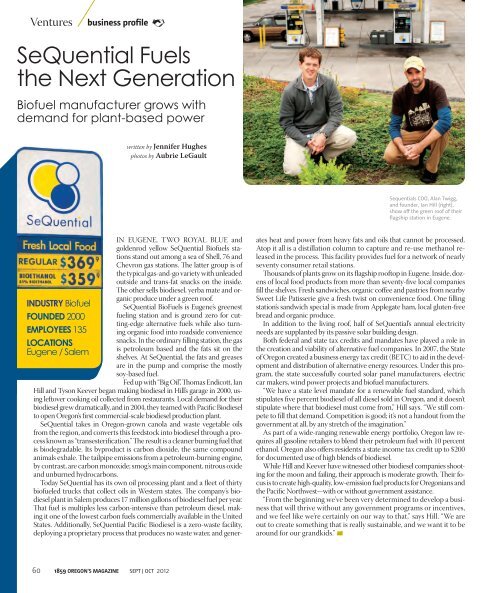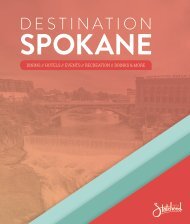You also want an ePaper? Increase the reach of your titles
YUMPU automatically turns print PDFs into web optimized ePapers that Google loves.
Ventures<br />
usiness prole<br />
SeQuential Fuels<br />
the Next Generation<br />
Biofuel manufacturer grows with<br />
demand for plant-based power<br />
written by Jennifer Hughes<br />
photos by Aubrie LeGault<br />
Sequentials COO, Alan Twigg,<br />
and founder, Ian Hill right,<br />
show off the green roof of their<br />
flagship station in Eugene.<br />
IN EUGENE, TWO ROYAL BLUE and<br />
goldenrod yellow SeQuential Biofuels stations<br />
stand out among a sea of Shell, 76 and<br />
Chevron gas stations. The latter group is of<br />
the typical gas-and-go variety with unleaded<br />
outside and trans-fat snacks on the inside.<br />
The other sells biodiesel, yerba mate and organic<br />
produce under a green roof.<br />
SeQuential BioFuels is Eugene’s greenest<br />
fueling station and is ground zero for cutting-edge<br />
alternative fuels while also turning<br />
organic food into roadside convenience<br />
snacks. In the ordinary filling station, the gas<br />
is petroleum based and the fats sit on the<br />
shelves. At SeQuential, the fats and greases<br />
are in the pump and comprise the mostly<br />
soy-based fuel.<br />
Fed up with “Big Oil”, Thomas Endicott, Ian<br />
Hill and Tyson Keever began making biodiesel in Hill’s garage in 2000, using<br />
leftover cooking oil collected from restaurants. Local demand for their<br />
biodiesel grew dramatically, and in 2004, they teamed with Pacific Biodiesel<br />
to open Oregon’s first commercial-scale biodiesel production plant.<br />
SeQuential takes in Oregon-grown canola and waste vegetable oils<br />
from the region, and converts this feedstock into biodiesel through a process<br />
known as “transesterification.” The result is a cleaner burning fuel that<br />
is biodegradable. Its byproduct is carbon dioxide, the same compound<br />
animals exhale. The tailpipe emissions from a petroleum-burning engine,<br />
by contrast, are carbon monoxide; smog’s main component, nitrous oxide<br />
and unburned hydrocarbons.<br />
Today SeQuential has its own oil processing plant and a fleet of thirty<br />
biofueled trucks that collect oils in Western states. The company’s biodiesel<br />
plant in Salem produces 17 million gallons of biodiesel fuel per year.<br />
That fuel is multiples less carbon-intensive than petroleum diesel, making<br />
it one of the lowest carbon fuels commercially available in the United<br />
States. Additionally, SeQuential Pacific Biodiesel is a zero-waste facility,<br />
deploying a proprietary process that produces no waste water, and generates<br />
heat and power from heavy fats and oils that cannot be processed.<br />
Atop it all is a distillation column to capture and re-use methanol released<br />
in the process. This facility provides fuel for a network of nearly<br />
seventy consumer retail stations.<br />
Thousands of plants grow on its flagship rooftop in Eugene. Inside, dozens<br />
of local food products from more than seventy-five local companies<br />
fill the shelves. Fresh sandwiches, organic coffee and pastries from nearby<br />
Sweet Life Patisserie give a fresh twist on convenience food. One filling<br />
station’s sandwich special is made from Applegate ham, local gluten-free<br />
bread and organic produce.<br />
In addition to the living roof, half of SeQuential’s annual electricity<br />
needs are supplanted by its passive solar building design.<br />
Both federal and state tax credits and mandates have played a role in<br />
the creation and viability of alternative fuel companies. In 2007, the State<br />
of Oregon created a business energy tax credit (BETC) to aid in the development<br />
and distribution of alternative energy resources. Under this program,<br />
the state successfully courted solar panel manufacturers, electric<br />
car makers, wind power projects and biofuel manufacturers.<br />
“We have a state level mandate for a renewable fuel standard, which<br />
stipulates five percent biodiesel of all diesel sold in Oregon, and it doesn’t<br />
stipulate where that biodiesel must come from,” Hill says. “We still compete<br />
to fill that demand. Competition is good; it’s not a handout from the<br />
government at all, by any stretch of the imagination.”<br />
As part of a wide-ranging renewable energy portfolio, Oregon law requires<br />
all gasoline retailers to blend their petroleum fuel with 10 percent<br />
ethanol. Oregon also offers residents a state income tax credit up to $200<br />
for documented use of high blends of biodiesel.<br />
While Hill and Keever have witnessed other biodiesel companies shooting<br />
for the moon and failing, their approach is moderate growth. Their focus<br />
is to create high-quality, low-emission fuel products for Oregonians and<br />
the Pacific Northwest—with or without government assistance.<br />
“From the beginning we’ve been very determined to develop a business<br />
that will thrive without any government programs or incentives,<br />
and we feel like we’re certainly on our way to that,” says Hill. “We are<br />
out to create something that is really sustainable, and we want it to be<br />
around for our grandkids.”<br />
60 <strong>1859</strong> oregon's mAgAzine SEPT OCT <strong>2012</strong>

















